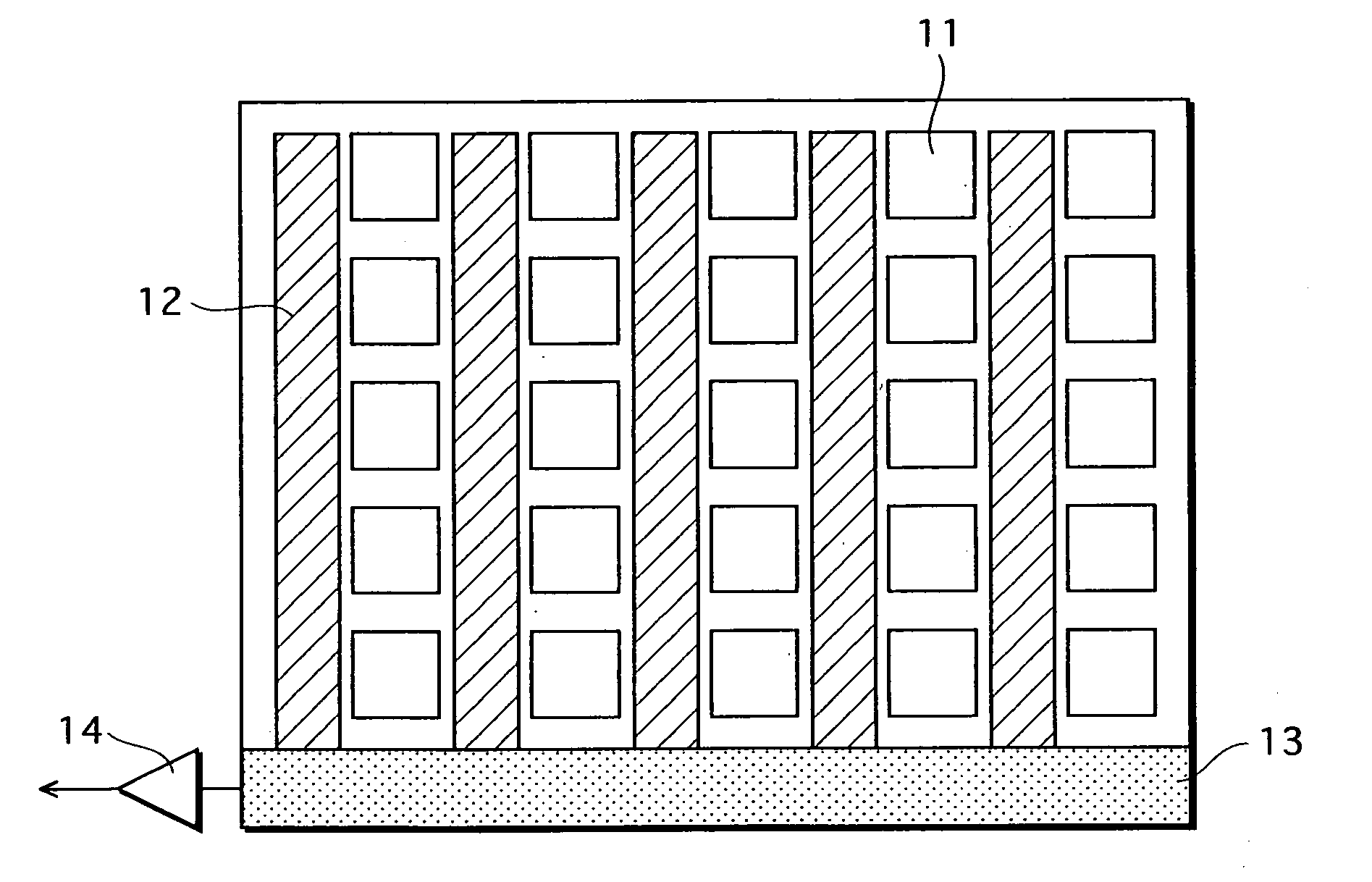Light-detecting device and manufacturing method thereof
a technology of light-detecting devices and manufacturing methods, which is applied in the direction of sustainable manufacturing/processing, crystal growth process, final product manufacturing, etc., can solve the problems of distortion stress, distortion stress, and the inability to realize low-power solid-state image pickup devices, so as to improve the gettering effect and reduce the electric characteristic variation
- Summary
- Abstract
- Description
- Claims
- Application Information
AI Technical Summary
Benefits of technology
Problems solved by technology
Method used
Image
Examples
first embodiment
[0057]FIG. 1 shows a schematic construction of an IT-CCD type solid-state image pickup device.
[0058]The solid-state image pickup device includes a plurality of light-detecting units 11, a plurality of vertical transferring units 12, a horizontal transferring unit 13, and an amplifying unit 14.
[0059]The plurality of light-detecting units 11 are arranged in a matrix in a plane to generate charges corresponding to the amount of received light. The plurality of light-detecting units 11 for 25 pixels of 5 rows and 5 columns are shown in FIG. 1. Each of the plurality of vertical transferring units 12 transfers the charge generated by each of the plurality of light-detecting units 11 to the horizontal transferring unit 13. The horizontal transferring unit 13 transfers the charge from each of the plurality of vertical transferring units 12 to the amplifying unit 14. The amplifying unit 14 converts the charge from the horizontal transferring unit 13 into a voltage and outputs it.
[0060]FIG. 2...
second embodiment
[0118]FIG. 11 shows a schematic construction of a FT-CCD type solid-state image pickup device.
[0119]The solid-state image pickup device includes a light-receiving region 41, an accumulation region 42, a horizontal transferring unit 43, and an amplifying unit 46.
[0120]The light-receiving region 41 has a plurality of light-detecting units 44. Each of the plurality of light-detecting units 44 generates a charge corresponding to the amount of received light, and functions as a vertical transferring unit. The accumulation region 42 has a plurality of accumulation units 45. Each of the plurality of accumulation units 45 accumulates the charge transferred from each of the plurality of light-detecting units 44, and functions as a vertical transferring unit. The plurality of light-detecting units 44 and the plurality of accumulation units 45 are arranged in a matrix in a plane. Each of the plurality of light-detecting units 44 and the plurality of accumulation units 45 for 66 pixels of 6 row...
third embodiment
[0129]FIG. 13 is a cross section of a light-receiving element for photocoupler.
[0130]The light-receiving element includes a semiconductor substrate 401, an epitaxial layer 402, an insulating film 408, a transparent electrode 409, and an antireflection film 416.
[0131]The semiconductor substrate 401 is composed of silicon as a base material and contains carbon and phosphorous. Carbon is substantially uniformly distributed in the semiconductor substrate 401 in a plane direction and a depth direction. A carbon concentration is in a range of 1×1016 atoms / cm3 to 2.5×1017 atoms / cm3 inclusive.
[0132]The epitaxial layer 402 includes a p-type well region 403 and a n-type region 404. The p-type well region 403 forms the overflow barrier electric potential ψofb between the n-type region 404 and the semiconductor substrate 401. A potential well is formed because the n-type region 404 is surrounded by the p-type well region 403. An area in which the potential well is formed corresponds to a light-...
PUM
| Property | Measurement | Unit |
|---|---|---|
| size | aaaaa | aaaaa |
| thickness | aaaaa | aaaaa |
| temperature | aaaaa | aaaaa |
Abstract
Description
Claims
Application Information
 Login to View More
Login to View More - R&D
- Intellectual Property
- Life Sciences
- Materials
- Tech Scout
- Unparalleled Data Quality
- Higher Quality Content
- 60% Fewer Hallucinations
Browse by: Latest US Patents, China's latest patents, Technical Efficacy Thesaurus, Application Domain, Technology Topic, Popular Technical Reports.
© 2025 PatSnap. All rights reserved.Legal|Privacy policy|Modern Slavery Act Transparency Statement|Sitemap|About US| Contact US: help@patsnap.com



